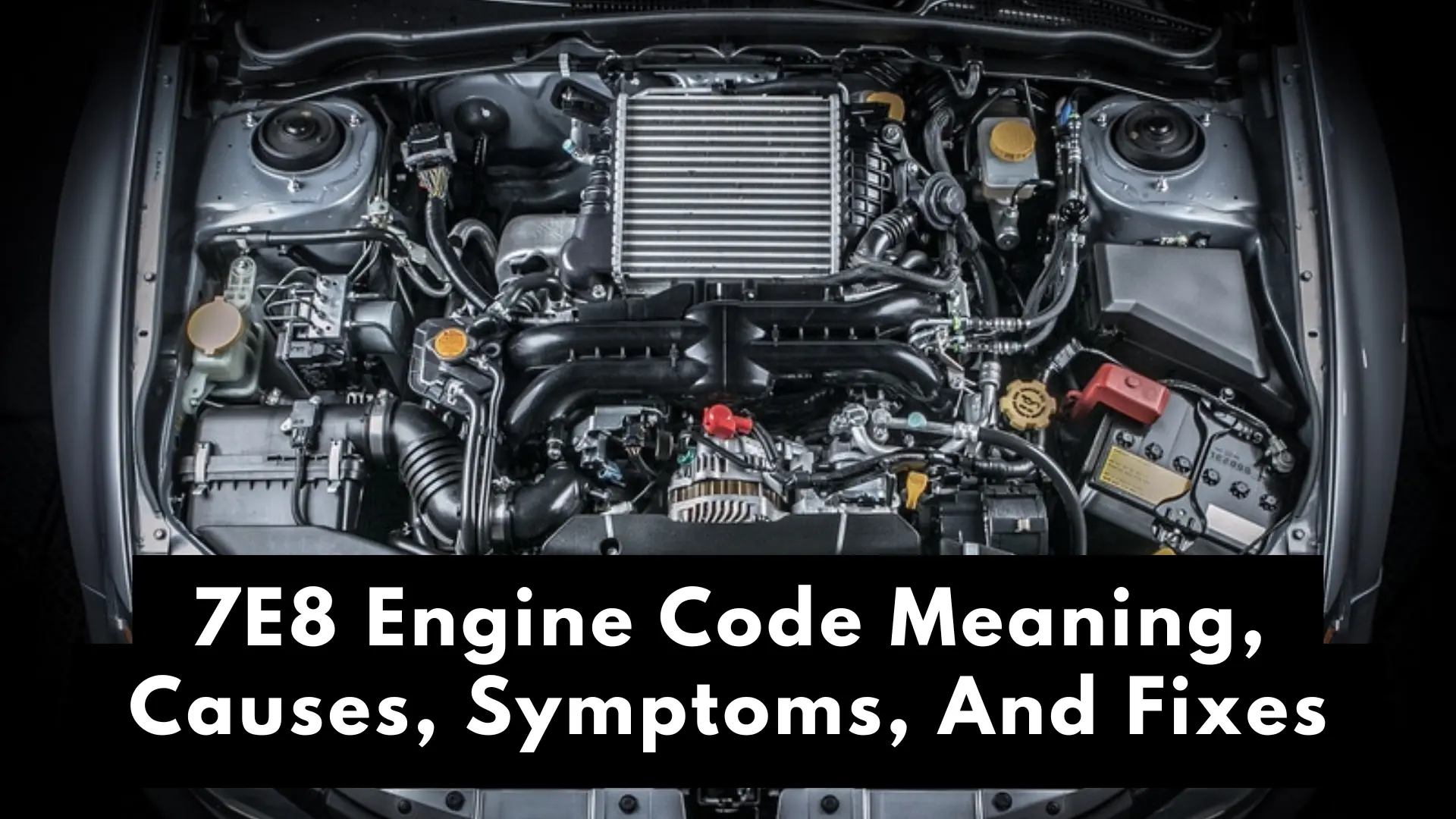7E8 Engine Code Meaning, Causes, Symptoms, and Fixes: 2025
When the check engine light illuminates on your dashboard, it can trigger a wave of anxiety. Among various fault codes that may appear, the 7E8 engine code stands out as a common yet crucial indicator.
Understanding this code is essential for any car owner who wants to maintain their vehicle’s health and performance. The 7E8 code typically relates to issues involving powertrain components and signals that something isn’t functioning optimally.
From understanding its implications in different car models to identifying potential causes and solutions, this guide will provide clarity on every aspect of the 7E8 engine code. Whether you’re facing issues or simply want to be informed about automotive diagnostics, let’s dive deeper into this important topic!
Overview of 7E8 Engine Code
The 7E8 engine code is a generic diagnostic trouble code (DTC) that often signifies issues related to the powertrain of a vehicle. This code primarily indicates that the Engine Control Module (ECM) has detected an anomaly within the system’s performance parameters. It’s essential for car owners and technicians alike to understand what this code represents.
Typically, the 7E8 engine code is seen in OBD-II equipped vehicles, which include most modern cars manufactured since 1996. Each manufacturer may assign different meanings or prioritizations to this DTC, but it generally points toward critical components such as sensors, fuel systems, or ignition systems needing inspection.
When scanned with an OBD-II reader, you might also encounter additional codes alongside 7E8. These supplementary codes can offer more context about specific faults affecting your vehicle’s operation. Hence, looking deeper into all related codes provides clearer insights into potential problems.
Understanding the implications of a 7E8 engine code allows drivers to make informed decisions regarding repairs and maintenance. Being proactive can prevent further damage and ensure smoother driving experiences down the road.
Understanding 7E8 Engine Code in Different Car Models
The 7E8 engine code is a diagnostic trouble code (DTC) that signals issues within the vehicle’s engine system. This code primarily indicates a problem on the powertrain side, which includes components like fuel systems and air intake. Understanding how this code interacts with different car models can help drivers identify potential problems early.
In many vehicles, especially modern ones, the 7E8 code may appear alongside other codes. These additional codes can offer context about specific malfunctions or failures occurring in conjunction with the 7E8 error. For example, its appearance might coincide with fuel delivery issues or sensor malfunctions.
Different manufacturers implement DTCs slightly differently based on their ECU (Engine Control Unit) programming. While some brands prioritize certain factors over others, it’s crucial to consult your car’s service manual for tailored information regarding your model’s interpretation of the 7E8 code.
Commonly affected makes include Ford, Honda, and Chevy/Chevrolet among others. Each brand may exhibit unique symptoms when faced with a 7E8 error signal—ranging from performance dips to increased emissions—making it essential for owners to understand these variances for effective troubleshooting.
| Vehicle / Engine Context | Notes on ‘7E8’ Context |
|---|---|
| Chevrolet Models (Cruze, Malibu, Traverse, Sonic, Suburban, Colorado, Camaro, Duramax, Tahoe, Silverado) | Sites like VehicleWhat refer to “7E8” in Chevrolets as prompting the ECM submenu where actual DTCs are accessed—various emission, O₂, intake or vacuum issues across models. |
| Toyota 3.5L V6 (Camry, Avalon, Highlander, 2004–2007) | AutomotiveGlory describes “7E8” as referring to a specific engine code (not related to OBD identifiers) for Toyota’s V6—more about engine naming than diagnostics. |
| GM 3.5L V6 (Traverse, Buick Enclave, GMC Acadia) | Another engine code reference (not diagnostic) from AutomotiveGlory includes GM’s 3.5L V6, sometimes called “7E8” in naming contexts. |
| Volkswagen 2.0T & 3.6L (Golf, Jetta, Passat, Tiguan, Touareg, etc.) | VolkswagenBuddy mentions “7E8” as an engine code tied to VW’s 2.0T and 3.6L engines—again referring to engine model codes, not OBD responses. |
Causes of 7E8 Engine Code
The 7E8 engine code often signals a problem related to the vehicle’s control module. This code is commonly associated with issues in the engine management system. When your car’s computer detects inconsistencies, it triggers this diagnostic trouble code.
Several factors can lead to the emergence of a 7E8 engine code. One frequent cause is faulty wiring or connections within the electrical system. Poor connections can disrupt communication between components and create erratic behavior, prompting error codes.
Another potential trigger is malfunctioning sensors, such as those monitoring oxygen levels or air intake. If these sensors send incorrect readings to the engine control unit (ECU), it may activate the 7E8 code as a warning signal.
Additionally, software glitches within the ECU itself can contribute to this issue. Sometimes updates are needed for optimal performance and compatibility with other systems in your vehicle. Identifying these underlying causes promptly helps maintain your car’s efficiency and reliability.
Common Triggers for the 7E8 Engine Code
The 7E8 engine code typically indicates a problem related to the vehicle’s transmission or powertrain control. It’s essential to identify the common triggers behind this code for effective troubleshooting. One prevalent cause is a malfunctioning oxygen sensor. When this sensor fails, it disrupts the fuel-to-air mixture and can lead to poor engine performance.
Another trigger for the 7E8 engine code can be an issue with the mass airflow sensor (MAF). If the MAF is dirty or damaged, it may send incorrect data to the Engine Control Unit (ECU), causing various performance issues and triggering error codes.
Vacuum leaks are also notorious culprits that can set off a 7E8 engine code. These leaks affect air intake pressure and can throw off your vehicle’s air-fuel ratio, leading to unwanted diagnostic trouble codes being generated.
Electrical issues such as corroded connectors or faulty wiring in related components might trigger this code too. Maintaining proper electrical connections is crucial for ensuring that all sensors communicate effectively with your car’s computer system.
Diagnosis of 7E8 Engine Code
Diagnosing the 7E8 engine code requires a systematic approach to identify underlying issues. It is essential to start with an OBD-II scanner, which reads error codes from your vehicle’s onboard computer. This tool will help pinpoint whether the 7E8 code appears alongside any additional trouble codes that could provide context for the problem.
Once you retrieve the 7E8 code, inspect related components thoroughly. Look for signs of wear or damage in sensors and wiring associated with emissions control systems. A thorough visual inspection can often reveal loose connections or frayed wires that contribute to triggering this specific code.
Next, consider checking fuel pressure and airflow as they are critical factors influencing engine performance. Any irregularities here may lead to improper combustion, resulting in the activation of various engine codes including 7E8.
Remember that while diagnosing, it’s crucial not just to focus on symptoms but also on how each component interacts within the wider system. This holistic view can simplify troubleshooting and expedite finding solutions effectively.
How to Properly Diagnose the 7E8 Engine Code
Diagnosing the 7E8 engine code requires a systematic approach to pinpoint the underlying issue. Start by connecting an OBD-II scanner to your vehicle’s diagnostic port. This device reads error codes stored in the engine control unit (ECU), providing valuable insights into what might be causing the problem.
Once you retrieve the 7E8 code, take note of any additional codes that may accompany it. Understanding these can help identify related issues or confirm if they share common triggers. Pay close attention to symptoms like poor performance, unusual noises, or warning lights on your dashboard.
Next, inspect key components such as sensors and wiring associated with fuel delivery and emissions systems. Look for signs of wear, damage, or loose connections that could lead to incorrect readings or malfunctions. A visual inspection often reveals hidden problems.
After checking physical components, consider running more specific tests based on your findings from previous steps. This could include testing sensor voltage outputs or monitoring live data while driving under various conditions to see how different elements interact with each other and affect overall performance.
Solutions for 7E8 Engine Code
Addressing the 7E8 engine code requires a methodical approach to ensure an effective resolution. First, it’s crucial to conduct a thorough visual inspection of your vehicle’s components. Check for any loose or disconnected wires in the engine management system. This simple step can sometimes reveal underlying issues that may be causing the code to trigger.
Next, consider running a diagnostic scan using an OBD-II scanner. This tool helps pinpoint specific problems related to the 7E8 code and provides valuable information on sensor performance and other parameters. By understanding what triggers this error, you can focus your efforts on resolving those particular issues.
If you’re not comfortable handling repairs yourself, seek help from a qualified mechanic. Professional technicians have experience dealing with complex codes like 7E8. They can perform advanced diagnostics and offer tailored solutions based on their findings.
If all else fails, resetting the Engine Control Module (ECM) might temporarily clear the code. However, this should only be seen as a stopgap measure until more permanent fixes are identified and implemented effectively.
Effective Ways to Resolve the 7E8 Engine Code Issues
Resolving the 7E8 engine code effectively begins with a thorough diagnostic process. Utilize an OBD-II scanner to confirm the code and check for any additional trouble codes that might be present. This step helps pinpoint specific issues affecting your vehicle’s performance.
Once you’ve identified potential problems, inspect crucial components such as the fuel system, spark plugs, and ignition coils. Issues in these areas often trigger the 7E8 engine code. Replace faulty parts as necessary, ensuring you use high-quality replacements that meet your vehicle’s specifications.
Another effective approach is resetting the check engine light after making repairs. This can sometimes clear temporary faults without requiring extensive work on other systems. However, it’s essential to monitor your vehicle afterward to ensure the issue doesn’t reappear.
If troubleshooting at home doesn’t yield results, visiting a professional mechanic may be necessary. They possess advanced diagnostic tools and expertise that can uncover underlying issues not easily detected by standard scanners or DIY methods.
Conclusion
Understanding the 7E8 engine code is vital for any car owner. This specific code relates to issues with your vehicle’s emissions system, often triggering a check engine light. Ignoring it can lead to more significant problems down the road.
Identifying the causes of a 7E8 code helps in diagnosing and resolving potential issues efficiently. Common triggers include sensor malfunctions or exhaust leaks. Being aware of these factors enables you to address them swiftly, potentially saving time and money.
Diagnosing this error involves using an OBD-II scanner and understanding what each reading means. A systematic approach ensures that no underlying problems are overlooked, leading to effective solutions tailored specifically for your car model.
Addressing the 7E8 engine code promptly not only improves performance but also maintains compliance with emissions regulations. Whether it’s a DIY fix or consulting with professionals, taking action will enhance your driving experience while ensuring safety on the road.
Related Articles:
7EA Engine Code
Mercedes-Benz ESP Inoperative

Kevin Morgan is an ASE-certified automotive engineer and blogger with over 15 years of experience in vehicle systems design, performance testing, mechanics, and diagnostics. He is deeply passionate about automotive excellence. As a contributing author at CarClinicCentral, Kevin shares his expertise with enthusiasts, providing valuable market insights, updates, and trends.


![Mercedes B5 Service: Cost & Checklist [Extensive Guide] 2025 3 mercedes b5 service](https://carcliniccentral.com/wp-content/uploads/2025/08/mercedes-b5-service-768x432.webp)

![Mitsubishi ASX Problems & Issues: Causes and Fixes [2025] 5 mitsubishi asx problems](https://carcliniccentral.com/wp-content/uploads/2025/09/mitsubishi-asx-problems-768x432.webp)
![Ford 8 Lug Bolt Pattern: Everything You Need To Know [2025] 6 ford 8 lug bolt pattern](https://carcliniccentral.com/wp-content/uploads/2025/09/ford-8-lug-bolt-pattern-768x432.webp)
![Mercedes A9 Service: Cost, Checklist, And Code [Guide 2025] 7 mercedes a9 service](https://carcliniccentral.com/wp-content/uploads/2025/08/mercedes-a9-service-768x432.webp)
